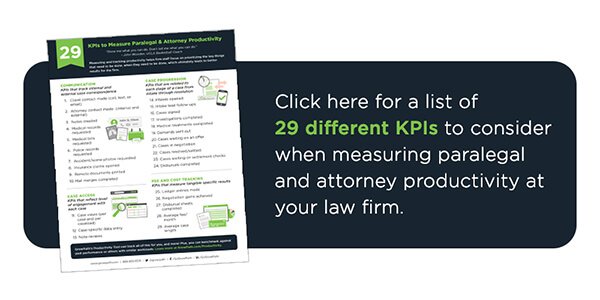How to Assess & Evaluate Employee Performance at Your Law Firm

Most law firms are creatures of habit. They go with what’s worked for a long time. That applies to everything from software to people. But what if it could be better?
Evaluating performance is crucial to success – for both case results and your bottom line – and your law firm’s system of evaluation, if it has one, has a huge impact on your organization’s performance. So what’s your method?
How to Assess Employee Performance at Your Law Firm: Three Methods
The evaluation of legal professionals can be a difficult topic in the legal industry. How can you tell they’re doing a good job? Whether it’s attorneys, paralegals, or anyone involved at the firm, law firm leadership often has an assessment method they prefer – and some are loathe to change it.
Over the years, we’ve seen three basic methods for evaluating law firm employees:
- The Gut
- The Group
- The Data
Many law firms use one or more of these evaluation methods, and each one has its pros and cons. So what are they?
The Gut – Evaluate Employee Performance by the Seat of Your Pants

For some in management roles, there is no better compass than gut feeling. It’s that “it” factor. It’s what your eyes tell you and what your stomach believes. Some managers feel they’ve just got good people sense, and it’s never failed them before.
Or has it?
Pros
The buck stops with one person. It’s your call, and you own it. You can make swift decisions and immediate changes when necessary. Fancy software is unnecessary. They’re doing well, or they’re not.
Cons
Going with your gut is gambling with more than the future of a good attorney or paralegal, it’s risking your law firm’s bottom line – and its culture. What if your gut is misleading you? What if you’re wrong and they’re far more or less productive than you believe?
Takeaway
The Gut is really the least reliable way to assess an employee’s performance. While there is, of course, a place for the eyeball test or to account for a feeling, it’s best to let the Gut be a prompt to dig into important KPIs rather than hand out a pink slip.
The Group – Assess Law Firm Employees by Committe

Probably the most common performance evaluation technique is to ask your people. Depending on the structure and size of the firm, this could be one person familiar with the employee in question, a department head, a supervisor, a manager, or a combination of all of these.
What could go wrong?
Pros
Supervisor perspectives should give you a more detailed idea of the legal work being done and how the employee is doing beyond simple billable hours. Things like how they follow up and how they deal with clients may be different than what you see. Consensus helps to counter bias and generally makes everyone more comfortable.
Cons
Additional perspectives don’t necessarily eliminate biases – they may actually add new ones, as people may have their own agendas to advance. They don’t always result in consensus either, bringing the specter of disagreement, squabbles, or discord. The employee could become a political football of a sort, and that’s never a good thing.
 Takeaway
Takeaway
Additional perspective is generally helpful when you’re doing any kind of professional performance assessment. If you’re not directly over the person being evaluated, you may not know their exact circumstances. But assessment by committee is often just a collection of gut feelings.
A mistake is unpalatable: You don’t want to risk losing an overloaded superstar or keeping an underperformer who drags the department down. What’s missing is hard data.
The Data – Measure Employee Performance Using Objective Facts

In any management system, there is data. Law firms that both capture and leverage their data are better at measuring employee performance and avoid a whole bunch of pitfalls.
Learn More: How much data is enough?
Pros
If your law firm has chosen its particular key performance indicators (KPIs) for employees, you’re ahead already. If you can measure employee performance, you can manage it. The more invested you are in measuring, the more you know about what your staff is doing and the results of their labor.
Mark may be the nicest guy in the world, but if his “case views” and “notes created” KPIs are lagging behind his colleagues’, tough questions need to be asked. When it comes to your team, you should know exactly how fast they work, and how well they work.
Cons
When you’re looking at hard data, you’re likely to learn some hard truths. Your law firm is a business, and the business’s performance is the ultimate goal. Data may force you to make some difficult decisions about everything from business objectives to workflow processes to personnel.
Gut(r), Group, and Data – Law Firm Employee Productivity Assessment
The best way of assessing employees at law firms is likely by supplementing hard data with feedback from team leads and your “eye test.” It may seem like common sense, but experience tells us differently about how employee productivity is measured in the real world. Together they can provide a solid, fair, evaluation process to determine what an employee can improve and where they’re crushing it.
Take the pros of each method if you can, and reduce the cons. Use all of them as tools in the evaluation process – but remember that only data is objective.
Simple Example of Law Firm Employee Productivity Evaluation
Every law firm is going to operate a bit differently, but here are the four broad steps in the employee evaluation process.
Step 1: Initiate a Review
Obviously, employees should be evaluated regularly. Beyond that, any of the three methods above can trigger a specific review. Maybe your gut tells you something has changed and you need to take a closer look. Maybe a supervisor or co-worker notices something different.
And different doesn’t always mean bad. If an employee is getting rave reviews that others are not, don’t you want to know how they’re doing it?
Step 2: Analyze the Data
Use the data you collect, and do an evaluation. Is the employee’s caseload lighter or heavier? Are there places their efficiency is slower or faster than the department or position average?
Are they hitting their goals? Are they being given sufficient opportunity to hit their goals? Identify the KPIs that matter most to your firm and evaluate employee performance from there.
Step 3: Discuss With Stakeholders
You don’t have to make a decision on your own if there are other stakeholders. As an attorney, you understand the value of the Socratic Method. Bring the data to the table and ask questions.
Why are they bottlenecked here? Is it a process or is it them? How are they getting X% more per settlement, or getting medical records five days sooner – whatever the metrics are, talk them through.
Step 4: Decide Your Firm’s Future
Ultimately, you want to support employees, give them a working process, and enable them to succeed. Sometimes, when you see and analyze the data in context, you find that the employee is doing the best with what’s available. Maybe you need a new process instead of a new paralegal. Maybe that attorney needs to make more phone calls.
Employee assessment isn’t necessarily the sword of Damocles for you or them. People are like law firms – they fall into comfortable routines, even if those routines aren’t ideal. Assessment is about getting better. Fixing or rewarding, not threatening or firing.
Client Testimonial: How GrowPath made a big difference in a big firm’s productivity
Choose the Right KPIs to Evaluate Employees, Set Performance Standards, and Establish Performance Goals
There’s a difference between tracking KPIs and tracking the right KPIs. Law department metrics can be a contentious subject – have you got the right metrics? Are you analyzing data the right way? Are you missing any key employee metrics that might sway decisions?
How do you establish performance goals? Truth be told, law firms that collect more of their data have the tools to make smarter decisions than law firms that don’t. Law firm KPIs don’t mean anything unless you can collect and measure the data.
So how does your law firm evaluate employee performance objectively and fairly? You could just let GrowPath and technology do the hard work for you. GrowPath users are closing cases months faster and generating millions more in revenue.
